This Is What Happens When You Travel Solo — And Why Every Man Should Do It
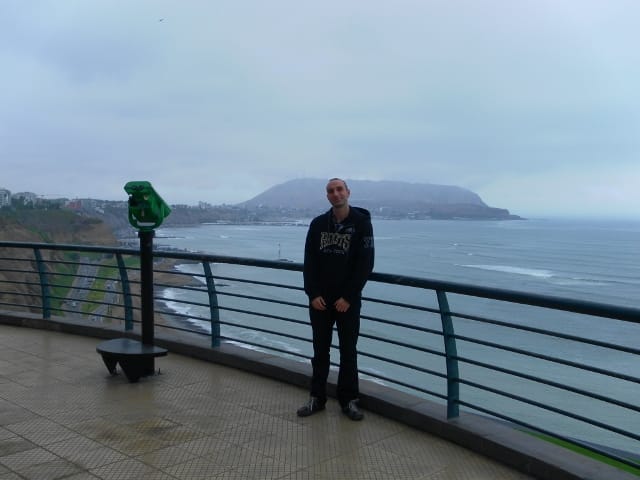
It was nighttime when I arrived in Lima.
I checked into the hostel and got set up in my dorm.
But now, something was bothering me.
I was extremely nervous and anxious like never before.
I wasn’t sure why. This was a trip of a lifetime. It’s something I’ve wanted to do for over a decade - ever since I was a university student binge watching Lonely Planet.
And yet, here I was alone, thousands of miles away, contemplating hiding out in my hostel for the next three weeks until it was time to go home.
Of course, that wasn’t an option.
I had planned this trip for months. I told my friends and family what I was going to do. I made an itinerary to follow. I couldn’t back down now.
I reached out to some people on social media. My cousin, who’s done a fair amount of traveling, got back to me.
He said “I remember feeling how you do right now. Don’t worry, it’ll go away after a couple of days.”
I wandered around the Miraflores area until it was time to go to sleep.
The following evening, I met with a former coworker for dinner after spending the day exploring the city.
The two of us worked for the same company in Toronto, but she’s originally from Peru and had recently moved home to Lima.
She could tell I was nervous. I had trouble communicating in Spanish with the wait staff. I was asking her all kinds of questions about the country, getting around, and staying safe.
Three weeks later, I was back in Lima. My flight was the following morning.
We decided to get dinner again.
She couldn’t believe her eyes.
In just a few weeks, my Spanish had improved significantly. My skin was tanned dark brown. I was clean shaven when I first arrived, but now sported a beard, and when I moved, I moved with confidence.
So what changed?
The day after our first dinner, I needed to catch a bus to Nazca.
I wasn’t sure how to do that. I asked around my hostel and got directions.
I made my way to the bus station and boarded the bus to Nazca, nervous that carrying a large backpack might make me a target for thieves.
I thought this bus ride was only going to be a few hours, but it took much longer. It was nighttime when we pulled into town.
The following day, I set out to do what I had come to Nazca for: taking a plane ride over the Nazca Lines.
The Nazca Lines are these large, ancient geoglyphs carved into the Peruvian desert, depicting animals, shapes, and lines. Their origin and purpose remain a mystery, though theories range from astronomical calendars to ritual pathways.
I took a taxi to the airport and bought a ticket.
However, I wasn’t going up alone. Three other guys were joining me on this flight.
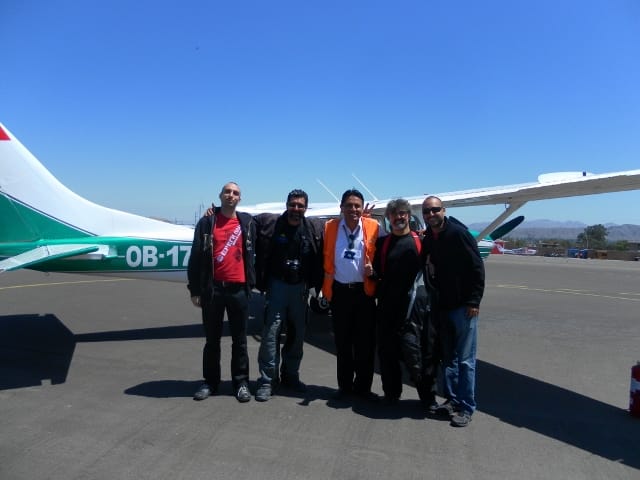
These guys were longtime friends traveling through South America by motorcycle, and had ridden all the way from Mexico.
The entire time, they were joking and laughing with me, the pilot, and each other. They had great energy.
The Nazca Lines themselves are a little overrated, but worth seeing once. However, hanging out with those guys was the most memorable part of being in Nazca.
My next stop was Puno, on Lake Titicaca, to see the Uros Islands.
I jumped an overnight bus to Arequipa, stopped to use the toilet - where they charge you on the way in, give you a handful of paper, and there’s no seat - before catching a connecting bus to Puno.
There was a young boy on the bus who took an interest in me and wanted to talk.
I figured this was a good time to practice my Spanish. I took a course in university, but didn’t find many opportunities to practice before coming to Peru.
Needless to say, I struggled with that conversation.
By the time I got checked into my hostel in Puno, I had been riding a bus for almost an entire day. I was so beat that I didn’t know what to deal with first.
I smelled bad and needed a shower.
I was starving and had to eat something.
I was exhausted and craving sleep.
These long bus rides are a killer. I got cleaned up, found a nice restaurant, and crashed hard.
When I woke up the next morning, I set out for the Uros Islands.
To avoid the Spanish Conquistadors moving through the region in the 1500s, native Peruvians constructed floating islands out of totora reeds.
These islands are still inhabited today.
I found a company to rent a kayak for the day.
When they noticed I was alone, they paired me up with another solo traveler.
I wish I could remember his name, or where he was from; because we had a great time paddling out to the islands, visiting with the people, and getting to learn about their history and culture.
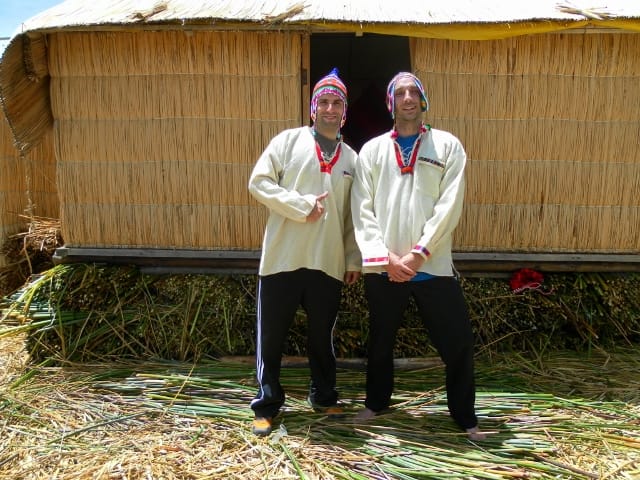
My next destination was Cuzco. I found a tour bus company heading there while making stops along the way at various sites. I figured it was a good way to see more of the country and break up the long ride.
However, as we were trying to leave the city, we were stopped.
There was a political demonstration going on, and the protesters blocked traffic.
I know better than to get involved in the politics of another country, but I was upset with the inconvenience.
Our tour guide informed us that all we could do was wait. These protests often get violent and people sometimes get killed.
The demonstration ended and we eventually got going, but a couple of the stops we were planning to make got trimmed due to time.
The best part of the tour was stopping for lunch at a restaurant where there were llamas hanging around outside.
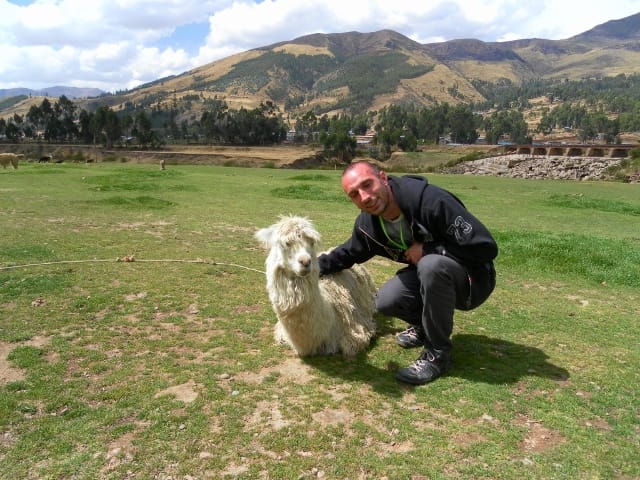
Cuzco was a fun place to hang out. It was warmer than Puno, but more touristy.
I spent a day wandering the city and checking out museums before embarking on a four day hike on the Salkantay trail to Machu Picchu.
I was not prepared for what came next.
It started with an early morning wakeup to catch a bus to the beginning of the trail.
Once we got hiking, I quickly found myself overwhelmed.
I was not ready for the high altitude.
I was in pretty good shape and doing a lot of yoga at the time, but I struggled to keep up and got passed by other hikers smoking cigarettes and drinking Inca Cola.
Most of the walking was uphill.
I chewed coca leaves to help with the altitude, but it was only a minor boost.
Making things even worse, I picked the wrong shoes for this hike.
The running shoes I brought quickly fell apart on the sharp rocks that were all over the mountains.
The soles flopped around like they were wide open mouths. I tried wrapping them in duct tape, but it didn’t hold. Rocks would get inside. Over damp terrain, my feet got wet.
There was nowhere to buy replacements.
The camp where we spent the first night was freezing cold and windy.
There were many people on this hike, but I didn’t connect with any of them.
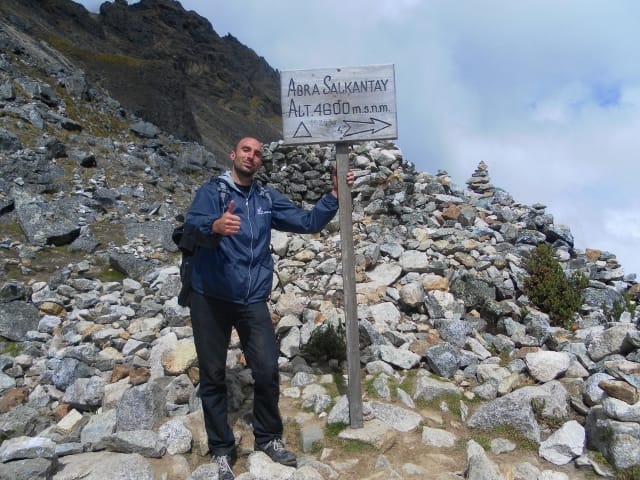
The following days were a little easier.
We started descending. The climate got a little warmer.
My shoes were still destroyed.
The Salkantay trail is normally a five day hike, but the tour operator also offered a four day trek; which I opted for.
Apparently, I was the only one.
A car came to pick me up and drive me the rest of the way to Aguas Calientes - a tourist hub at the base of Machu Picchu.
My driver didn’t speak English, and my Spanish was poor; but the ride to Aguas Calientes was a blast.
This guy drove like a maniac - speeding down gravel roads, drifting around corners, music blasting. I was grinning like an idiot with the wind blowing in my face and my adrenaline kicking hard.
I arrived to town, checked into my hostel and took a very long shower.
Then I went out to buy new shoes.
There wasn’t a proper shoe store, but one of the souvenir stands had a pair that fit me embroidered with an Incan inspired pattern. In Peru, they screamed tourist, but in Toronto, they received a few compliments.
The next morning, I set out for the main attraction.
After spending 30 minutes climbing stairs, you’re at the entrance to Machu Picchu - or you can just take the bus.
It’s a big site. There’s a lot of places to wander around, but you can see it in half a day.
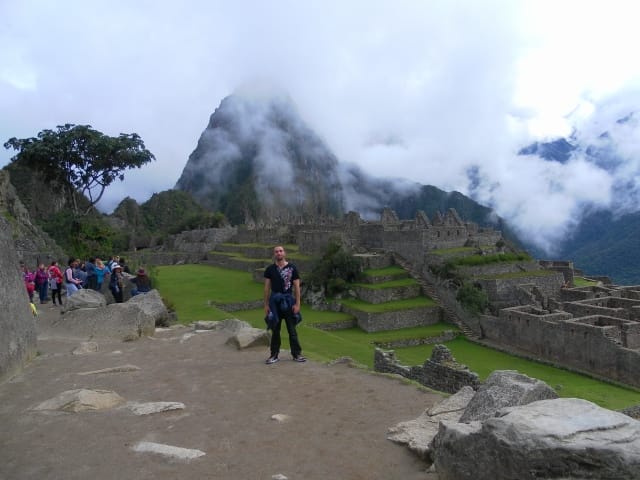
My biggest memory of Machu Picchu was meeting a young couple from America who had just gotten married and were visiting Peru for their honeymoon.
It didn’t take long to figure out that these two were devout Christians, and they were curious about my views on God.
At the time, I was into a liberal, new-age brand of spirituality. Even though I had grown up Christian, I hadn’t been living that way for some time, and Orthodoxy wasn’t even on my radar.
We spent the rest of the day having a deep conversation about God, Christianity, life, the universe, philosophy, and everything else.
They strongly urged me to return to God, give Christianity another chance, and to start going back to church.
Even though I eventually did, I wish I listened to them when we were at Machu Picchu.
My last stop in Peru was Iquitos - a city not accessible by road in the heart of the Amazon rainforest.
Like many others, I listened to the Joe Rogan Experience about his guest’s ayahuasca experience, and was inspired to try it for myself.
I flew from Cuzco to Lima, and since my connecting flight was early in the morning, I decided to spend the night in the airport.
I arrived to Iquitos, and got checked in.
On the door to my hostel, there was a poster warning travelers of a British expat who lived in town and was known for scamming tourists.
He was a drug addict who would approach people with a hard-luck story about being attacked and robbed while showing off his broken pinky finger.
Partway through the week, I ran into this guy on the street.
Sure enough, he came up to me with the exact story that was written on the poster in my hostel.
I knew exactly what he was going to say and told him I wasn’t going to help him. He left me alone after that.
When I got back to the hostel, I ran into the owner. He was a younger guy from Brazil.
“Hey man, I ran into your friend today.”
“Huh?”
”Yeah, the guy from the poster on the front door. He came up to me. It went exactly as you said it would.”
“Really? Fuck that guy. I fucking hate that piece of shit. He’s scammed four of my guests so far, and every time he steals from someone staying here, I go find him and kick the shit out of him.”
“Well, he didn’t get me today.”
“That’s good. Seriously, watch out for that guy.”
When I first got to Iquitos, I set out to find a shaman for some ayahuasca ceremonies, but wasn’t sure how to go about it.
The places I found online were expensive. Some of the people selling tourist excursions on the street offered ayahuasca ceremonies, but it seemed sketchy - since they also wanted to sell me marijuana and cocaine.
Fortunately, I met another traveler at my hostel from France. He was an older gentleman who was fluent in several languages.
He was able to help me with my Spanish and assist me in finding a good spot for ayahuasca ceremonies.
I ended up doing ayahuasca three times over the course of that week.
It was a unique experience, but a little overrated and not the deep introspective adventure I thought it would be.
You get sick, and it takes about half of the following day to recover.
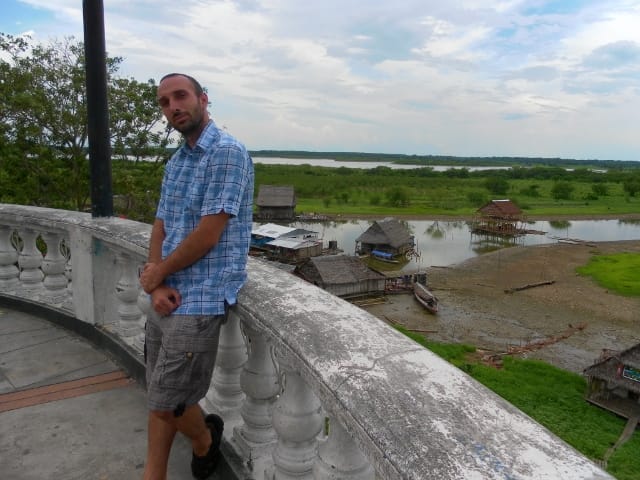
Iquitos itself was pretty cool. The weather was warm and humid. I was riding in the back of tuk tuks and motorbikes, instead of cars.
Me and the French guy from the hostel found a cool restaurant built in the middle of the Amazon basin only accessible by boat.
It was a great way to end my trip before going home to Canada - but first I arranged to meet my former coworker again for dinner.
It’s no wonder why I seemed so different to her from my first day in Lima.
It had been only three weeks, but during that time, I had several adventures all over the country.
I faced hardship and setbacks - exhaustion, hunger, discomfort, and pain.
I met new people I’ll never forget.
I experienced all manner of highs and lows along the way.
I forced myself to grow.
To get by in a different language.
To expand beyond my comfort zone.
And that’s why people should travel solo - you get to do your trip your way, and grow as a result.
Don’t take off to some popular resort and get drunk on the beach for a week.
Don’t sign up for some package tour that manages everything and herds you place to place like cattle.
Taking a solo trip requires planning, research, problem solving, communication, and a host of other skills.
You’ll lose sleep on overnight buses. You’ll butcher the local language. You’ll get lost, frustrated, maybe even scared. But you’ll figure it out. And when you do, you’ll come back sharper, stronger, and more grounded than when you left.
Going alone means that you get to travel how you want. You don’t need to worry about anybody else.
If you don’t like a place, you can leave. If you want to stick around, go ahead.
If there’s a unique experience that appeals to you, that others may think is weird, nobody is going to stop you. Just be careful.
Yes, it takes money, but depending on your travel style, it may not be as much as you think. It can definitely be less expensive than those highly advertised package tours and resorts.
Don’t wait a decade to take the trip of a lifetime like I did. Stop waiting. Pick a place, book your ticket, and go.
You’ll be glad you did.
If this story resonated, hit subscribe and bookmark the page. I’ve got more coming.
Thanks for reading — and God bless.
Member discussion